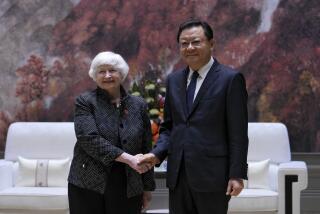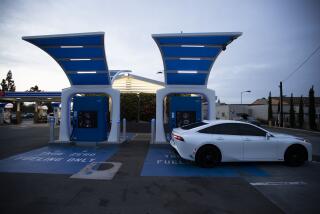What’s good for GM may be developed in China
General Motors Corp. put its money where its market is Monday as it announced plans for an ambitious research facility to explore alternative fuels and improve the fuel efficiency of its vehicles sold in China.
The Center for Advanced Science and Research will be on a new $250-million corporate campus in the Pudong area of Shanghai that also will serve as home to the automaker’s Asia Pacific headquarters. The first phase is to be completed late next year.
“[We’re] going beyond mere words by making investments in new technology, in new institutions and research and science development here in China, that will help take some of these promising technologies that you’ve seen and heard about today from the blackboard to the blacktop,” said Kevin Wale, president and general manager of General Motors China.
GM said researchers would explore technologies for producing ethanol from plant products such as cornstalks, study new lightweight materials that could improve the energy efficiency of vehicles by reducing mass, and work on new manufacturing processes that consume less energy, produce less waste and emissions and recycle more materials.
The automaker joins a growing number of multinational corporations attracted to China not merely as a cheap source of factory labor but also because of the nation’s growing pool of engineers and scientists. Earlier this year, China’s Ministry of Commerce estimated that there were more than 800 foreign-backed research centers in the country, up from about 100 six years ago.
“For GM, an obvious advantage of doing this is that it will be able to enjoy low-cost R&D while getting better access to the local market and probably winning more government support” for future projects, said Mei Xinyu, research analyst at the Ministry of Commerce in Beijing.
The site of Monday’s announcement, the verdant grounds of the Diao Yu Tai State Guest House, signaled the government’s interest and approval of GM’s initiative. The setting usually is reserved for foreign dignitaries.
GM’s willingness to invest in research to help China reduce its reliance on petroleum and cut the pollution that casts a gray pall over Beijing underscores the market’s importance to the Detroit automaker.
As GM has struggled to offset slumping North American sales, China has been a bright spot. It is GM’s second-largest market, and the company expects to sell more than 1 million vehicles here this year, up some 20% from a year ago.
“Fuel shortages have become a more prominent problem in China, and energy-saving [vehicles] will definitely become a larger trend in China in the future,” said Jia Xinguang, chief analyst at the China National Automotive Industry Consulting and Development Corp. in Beijing. “Therefore, it is market demand in China that pushed GM to make such an investment decision.”
GM and its venture partner in China, Shanghai Automotive Industry Corp. Group, also pledged $5 million to create the China Automotive Energy Research Center, a think tank at Tsinghua University in Beijing that would explore ways to reduce China’s reliance on petroleum.
“These challenges are not just impacting China, they are increasingly being felt around the world,” said GM Chairman and Chief Executive Rick Wagoner. “The time for addressing these challenges is not tomorrow; it’s today. And the responsibility does not belong to someone else; it belongs to me, to you, to all of us with a stake in China’s future.”
GM’s commitment to finding new sources of energy to replace fossil fuels and developing more hybrid vehicles comes as Japanese rivals Toyota Motor Corp., Honda Motor Co. and Nissan Motor Co. show off their new green vehicles at the Tokyo Motor Show.
As Jia sees it, GM and Toyota are running neck and neck in the race to be the technological leader in hybrid energy vehicles. However, he noted, “Toyota has already done lots of preparation work in China, including lots of marketing. And it is already producing hybrid cars in China, a step ahead of GM. All Toyota is waiting for is a change in government policy, and whenever that happens, it can start to sell its cars right away.”
dawn.chmielewski
@latimes.com







